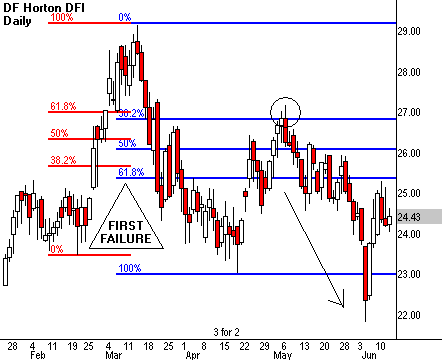Fibonacci jumped into the technical mainstream late in the bull market. Futures traders had it all to themselves until real-time software ported it over to the equity markets. Its popularity exploded as retail traders experimented with its arcane math and discovered its many virtues.
Fibonacci ratios describe the interaction between trend and countertrend markets — 38%, 50% and 62% retracements form the primary pullback levels. Apply these percentages after a trend in either direction to predict the extent of the countertrend swing. Stretch a grid over the most obvious up or down wave, and see how percentages cross key price levels.
Convergence between pattern and retracement can point to excellent trading opportunities. Keep in mind that retracements work poorly in a vacuum. Always examine highs, lows and moving averages to confirm the importance of a specific level.
Discord between retracement and the underlying pattern generates noise instead of profit. Move on to a new chart when nothing lines up correctly. This divergence generates most of the whipsaw in a price chart. Alternatively, strong phasing between Fibonacci and pattern exposes highly predictive reversals at narrow price levels.
Let’s look at five tricks to improve your Fibonacci skills. Add these twists and turns to your toolbox and apply them to your next trade. I promise they’ll serve you very well in the years ahead.
First Rise/First Failure

First Rise/First Failure marks the first 100% retracement of a trend within your time frame of interest. It provides an early reversal warning after a new high or low. The 100% retracement violates the major price direction and terminates the trend it corrects. From this level, the old trend can reestablish itself if it breaks through the old 38% level. More often, traders will use that level to enter low-risk positions against the old trend.
Parabola Hunt

Parabolic movement tends to occur between the 0%-to-38% and 62%-to-100% Fibonacci levels in all trends. This tendency offers a great tool for finding the big moves when looking for trades. Watch for congestion to form at the 38% or 62% level. Then use a simple breakout or breakdown strategy when price moves past it. The next thrust can be dramatic, with price moving like a magnet back to an old high or low. Of course, the strategy only works when you can find these levels in advance.
Continuation Gap Extensions

You can often target the exact price a rally or selloff will end at by using the continuation gap as a Fibonacci extension tool. Identify the gap by its location at the dead center of a vertical price wave. Then start a Fib grid at the beginning of the trend and extend it so the gap sits under the 50% retracement level. The grid extension points to the terminating price for the rally or selloff.
Overnight Grids

Find an active stock and start a grid from the high (or low) of a session’s last hour. Stretch the grid to the opposite end of the next morning’s first hour low (or high). This defines a specific price wave traders can use to uncover intraday reversals, breakouts and breakdowns. The overnight grid also offers a way to trade morning gaps. The gap will often stretch across a key retracement level and target low-risk entry on a pullback.
Second High/Low

Many traders can’t figure out where to start a Fib grid. Here’s a trick to help you place it where it’ll do the most good. The absolute high or low in a price wave isn’t the best starting point for a grid most of the time. Instead, look for a small double bottom or double top within the congestion where the trend began. Swing one end of the grid over this second high (or low), instead of the first. This will capture a specific Elliott Wave that conforms to the trend you’re trying to trade.